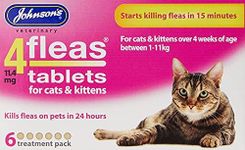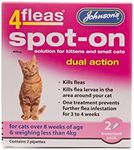Buying Guide for the Best Oral Flea Treatment For Cats
Choosing the right oral flea treatment for your cat is crucial for their health and comfort. Fleas can cause a range of issues from mild irritation to serious health problems. When selecting an oral flea treatment, it's important to consider several key specifications to ensure you pick the best option for your feline friend. Here are the key specs you should focus on and how to navigate them.Active IngredientsActive ingredients are the chemicals in the treatment that kill or repel fleas. This spec is important because different ingredients work in different ways and can have varying levels of effectiveness and safety. Common active ingredients include nitenpyram, spinosad, and lufenuron. Nitenpyram works quickly and is often used for immediate relief, while spinosad provides longer-lasting protection. Lufenuron prevents flea eggs from hatching. Choose an active ingredient based on how quickly you need results and whether you need ongoing protection.
Duration of EffectivenessThis spec indicates how long the treatment will remain effective after administration. It's important because it determines how often you need to give the treatment to your cat. Treatments can range from daily doses to monthly doses. If you prefer less frequent dosing, look for treatments that last a month or longer. For immediate but short-term relief, a daily treatment might be more suitable. Consider your schedule and how easy it is for you to administer the treatment regularly.
FormulationFormulation refers to the form in which the treatment is administered, such as tablets, chewables, or liquids. This is important because some cats may be more willing to take one form over another. Tablets can be hidden in food, chewables might be more palatable, and liquids can be mixed with food or water. Choose a formulation that you think your cat will accept easily to ensure they get the full dose.
Age and Weight RestrictionsAge and weight restrictions specify the minimum age and weight at which a cat can safely use the treatment. This is crucial for ensuring the safety and effectiveness of the product. Treatments are often formulated for specific age and weight ranges to prevent overdosing or underdosing. Check the product label to ensure it is suitable for your cat's age and weight. If you have a kitten or a very small or large cat, pay extra attention to this spec.
Side EffectsSide effects are potential adverse reactions that your cat might experience after taking the treatment. This spec is important because it helps you weigh the benefits against the risks. Common side effects can include vomiting, diarrhea, and lethargy. More serious side effects are rare but possible. Read reviews and consult your veterinarian to understand the likelihood and severity of side effects. Choose a treatment with minimal and manageable side effects, especially if your cat has a sensitive stomach or other health issues.
Speed of ActionSpeed of action refers to how quickly the treatment starts to work after administration. This is important if your cat is currently suffering from a flea infestation and needs immediate relief. Some treatments begin working within 30 minutes, while others may take a few hours. If your cat is in immediate discomfort, opt for a treatment with a faster speed of action. For ongoing prevention, the speed of action may be less critical.














